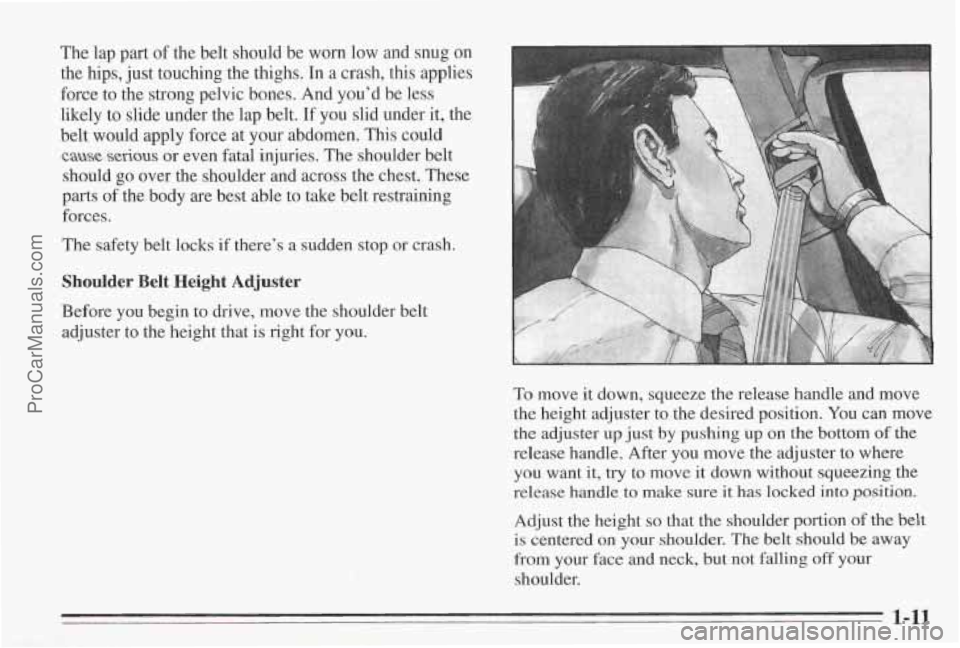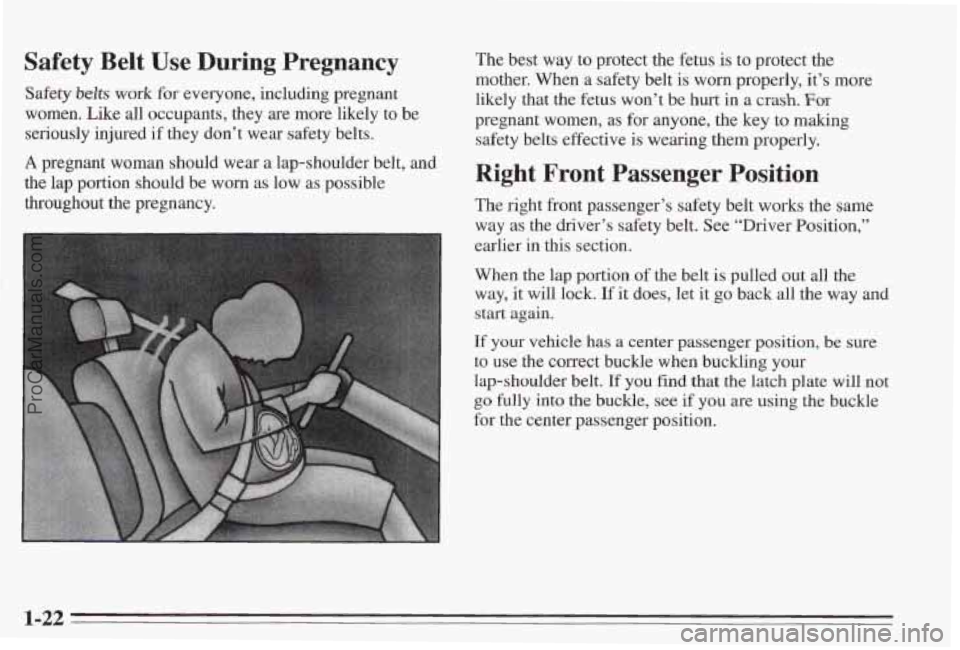Page 6 of 338
Vehicle Symbols
These are some of the symbols you may find on your vehicle.
For example,
these symbols
are used on
an
original battery:
POSSIBLE A
CAUTION
INJURY
PROTECT EYES BY
SHIELDING
CAUSTIC
ACID COULD BATTERY
CAUSE
BURNS
AVOID
SPARKS
OR
FLAMES
SPARK
OR ,\I/,
COULD FLAME
EXPLODE BAllERY
These symbols are
important
for you and
your passengers
whenever your
vehicle
is
driven:
DOOR LOCK
UNLOCK
FASTEN SEAT
4
BELTS
POWER
WINDNOW
These symbols
have
to do with
your lights:
SIGNALS 9
TURN
HIGH
LAMPSoR BEAM = =o
FOG LAMPS $0
These symbols
are on some of
your controls:
WIPER w
WINDsHIELDw DEFROSTER
WINDOW
DEFOGGER
VENTILATING
4 1
FAN CI
These symbols are used on
warning
and
indicator lights:
COOLANT Fe
TEMP --
ENGINE
CHARGING
I-1
BATTERY SYSTEM
BRAKE
(0)
RADIATOR COOLANT
a
FUEL @
ENGINE OIL
PRESSURE Wb
TEMP OIL 45
ANTI-LOCK (@)
BRAKE
Here are some
other symbols
you may see:
FUSE
RADIO
VOLUME
CONDITIONING
AIR 43
TRUNK
RELEASE
t
LIGHTER n
SPEAKER
V ProCarManuals.com
Page 8 of 338
Section 1 Seats and Restraint Systems
Here you'll
find information about the seats in your
Pontiac and how
to use your safety belts properly. You
can also learn about some things you should not do with
air bags and safety belts.
Seats and Seat Controls
This section tells you about the seats -- how to adjust them
-- and also about reclining seatbacks and head restraints.
Manual Front Seat
Pull up on the control bar under the front of the seat to
unlock it. Slide the seat to where you want it. Then
release the
bar and try to move the seat with your body,
to make sure the seat is locked
into place.
1-1 ProCarManuals.com
Page 10 of 338
R Reclining Front Seatbacks
c
l)i # Adjusts the position of the seatback side bolsters.
Tilts the rear of the seat up or down.
Tilts the front of the seat up or down.
Lumbar Controls:
d! Reshapes the lower back area of the seat.
Jv Reshapes the middle back area of the seat.
4 Reshapes the upper back area of the seat.
8,
Lift the lever to release the seatback, then tilt the
seatback forward
or backward as desired. Release the
lever to lock the seatback in place.
1-3
ProCarManuals.com
Page 17 of 338
Driver Position
This part describes the driver’s restraint system.
Lap-Shoulder Belt
The driver has a lap-shoulder belt. Here’s how to wear it
properly.
1. Close and lock the door.
2. Adjust the seat (to see how, see “Seats” in the Index)
so you can sit up straight.
3. Pick up the latch plate and pull the belt across you.
4. Push the latch plate into the buckle until it clicks.
Don’t let it get twisted.
Pull
up on the latch plate to make sure it is secure. If
the belt isn’t long enough, see “Safety Belt
Extender’’ at the end of
ths section.
Make sure the release button
on the buckle is
positioned
so you would be able to unbuckle the
safety belt quickly if you ever had to.
1-10
ProCarManuals.com
Page 18 of 338

The lap part of the belt should be worn low and snug on
the hips, just touching the thighs. In
a crash, this applies
force to the strong pelvic bones. And you’d be less
likely to slide under the lap belt. If you slid under it, the
belt would apply force at your abdomen. This could
cause serious or even fatal injuries. The shoulder belt
should
go over the shoulder and across the chest. These
parts of the body are best able to take belt restraining
forces.
The safety belt locks if there’s a sudden stop or crash.
Shoulder Belt Height Adjuster
Before you begin to drive, move the shoulder belt
adjuster to the height that
is right for you.
To move it down, squeeze the release handle and move
the height adjuster to the desired position.
You can move
the adjuster
up just by pushing up on the bottom of the
release handle. After you move the adjuster to where
you want it,
try to move it down without squeezing the
release handle to
make sure it has locked into pasition
Adjust the height so that the shoulder portion of the belt
is centered on your shoulder. The belt should be away
from your face and-neck, but not falling off your
shoulder.
1-11
ProCarManuals.com
Page 29 of 338

Safety Belt Use During Pregnancy
Safety belts work for everyone, including pregnant
women. Like all occupants, they are more likely to be
seriously injured
if they don’t wear safety belts.
A pregnant woman should wear a lap-shoulder belt, and
the lap portion should be
worn as low as possible
throughout the pregnancy.
The best way to protect the fetus is t’o protect the
mother. When a safety belt is worn properly, it’s more
likely that the fetus won’t be
hurt in a crash. FOT
pregnant women, as for anyone, the key to making
safety belts effective is wearing them properly.
Right Front Passenger Position
The right front passenger’s safety belt works the same
way as the driver’s safety belt. See “Driver Position,”
earlier in
this section.
’ When the lap portion of the belt is pulled out all the
way, it will lock.
If it does, let it go back all the way and
start again.
If your vehicle has a center passenger position, be sure
to use the correct buckle when buckling your
lap-shoulder belt.
If you find that the latch plate will not
go fully into the buckle, see if you are using the buckle
for the center passenger position.
1-22
ProCarManuals.com
Page 32 of 338
!. Pick up the latch plate and pull the belt across you.
2. Push the latch plate into the buckle until it clicks.
Don’t let
it get twisted.
Pull up on the latch plate to make sure it is secure, When
the lap belt
is pulled out all the way, it will
lock.
If it does, let it go back all the way and start
again.
If the belt is not long enough, see “Safety Belt
Extender” at the end of this section. Make sure the
release button
on the buckle is positioned so you
would be able to unbuckle the safety belt quickly if
you ever had to.
The lap part of the belt should be worn low
and snug on
the hips, just touching the thighs. In a crash, this applies
1-25
ProCarManuals.com
Page 33 of 338
force to the strong pelvic bones. And you’d be less
likely to slide under the lap belt.
If you slid under it, the
belt would apply
force at your abdomen. This could
cause serious or even fatal injuries. The shoulder belt
should
go over the shoulder and across the chest. These
parts of the body are best able to take belt restraining
forces.
The safety belt locks if there’s a sudden stop or a crash.
To unlatch the belt, just push the button on the buckle.
1-26
ProCarManuals.com